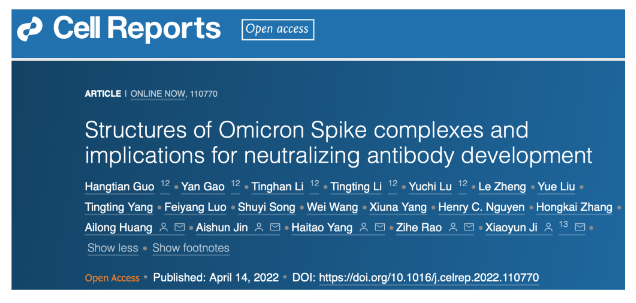The COVID-19 pandemic caused by Severe Acute Respiratory Syndrome Coronavirus 2 (SARS-CoV-2) presents an unprecedented global public health threat. The emergence of the Omicron variant has led to widespread transmission and continuous challenges to the development of neutralizing antibodies and vaccines. The Omicron variant has a high number of mutations, with up to 37 mutations in the Spike protein. Recent studies have indicated that many of the current neutralizing antibodies against SARS-CoV-2 are ineffective or have significantly reduced potency against Omicron variants. Therefore, an in-depth understanding of the molecular mechanism of immune evasion by Omicron variants is crucial to developing broad-spectrum neutralizing antibodies against SARS-CoV-2.
On April 15th, 2022, Professor Xiaoyun Ji from the State Key Laboratory of Pharmaceutical Biotechnology and School of Life Sciences, Nanjing University, Professor Haitao Yang from the Shanghai Institute for Advanced Immunochemical Studies and School of Life Science and Technology, ShanghaiTech University, Academician Zihe Rao from Tsinghua University, as well as a joint team of Professors Ailong Huang and Aishun Jin from Chongqing Medical University, published an article titled Structures of Omicron Spike complexes and implications for neutralizing antibody development in the international journal Cell Reports. Using cryo-electron microscopy single-particle technique, the team analyzed high-resolution structures of the Omicron variant Spike protein binding to its receptor and antibodies, respectively. From a structural biology perspective, the team elucidated the molecular mechanism of the Omicron variant to evade most existing neutralizing antibodies while still retaining effective interaction with the ACE2 receptor. This research provides new insights into the design and development of broad-spectrum neutralizing antibodies.

The cryo-electron microscopy (cryo-EM) structure of the Omicron Spike-ACE2 complex was initially obtained at a resolution of 2.8 angstroms. Compared with the wild-type (WT) Spike, mutations on the Omicron RBD form new interactions with the amino acid residues in the first α-helix of the ACE2 receptor, allowing the Omicron Spike to maintain a tight binding affinity with ACE2. Surface plasmon resonance (SPR) experiments were also conducted to confirm the strong interaction between the Omicron Spike and ACE2.
The research team analyzed the structural information of a variety of antibody drugs that have been used as either monotherapy or combination therapy for COVID-19. Upon structural comparison, the research team discovered that the amino acid mutation sites on the Omicron RBD were obviously located within the epitope region of most neutralizing antibodies. These mutations would introduce steric hindrance and/or disrupt the specific interaction between the antibody and the RBD amino acid residues of Omicron. Structural analysis revealed that Omicron RBD mutations effectively blocked the binding of most neutralizing antibodies to RBD, but did not disrupt the binding of ACE2 to RBD, suggesting that mutations on RBD have dual effects on receptors and antibodies.
The research team then obtained the cryo-EM structures of neutralizing antibody 510A5 in complex with Spike proteins of the WT, Delta, and Omicron variants. 510A5 is an RBD-targeting neutralizing antibody that has been screened from serum samples of convalescent COVID-19 patients. Biochemical binding assays revealed that the binding ability of 510A5 to the Omicron Spike protein was decreased compared to the WT and Delta strains. Pseudovirus neutralization assays demonstrated immune escape of the Omicron variant against 510A5. Cryo-EM structures showed that the complexes of the WT and Delta Spike proteins with 510A5 Fabs exhibited a state of three Down RBDs, in which all three 510A5 Fabs could interact with two adjacent Down RBDs simultaneously, resulting in a closed state that was inaccessible to the receptor and blocking the receptor recognition process of the virus. However, the Omicron spike-510A5 Fab complex exhibited two binding modes: binding three or two 510A5 Fabs, respectively. The Omicron RBD mutation site significantly reduced the ability of 510A5 to bind RBD, resulting in the disappearance of the state of the three Down RBDs and the generation of an Up RBD that exposed the ACE2 binding site, providing direct evidence to explain the immune escape of Omicron variant strains.
Furthermore, the research team compared the recently reported antibodies that retain certain neutralizing activity against Omicron variant strains and analyzed the epitope characteristics and neutralizing modes of these antibodies. They found that the epitopes of class 3 and class 4 antibodies overlapped with the Omicron mutation sites less, making them more tolerant to Omicron variants. Based on these experimental results, the research team believes that the therapeutic strategy of targeting different epitopes simultaneously by cocktail antibodies may have a high potential for clinical application.

In conclusion, this study elucidated the molecular mechanisms by which Omicron interacts with ACE2 and escapes from neutralizing antibodies. These findings provide new insights into the immune evasion mechanisms of Omicron and lay the groundwork for vaccine development. Hangtian Guo, a PhD student from Nanjing University, Yan Gao, an associate researcher from ShanghaiTech University, Tinghan Li, an assistant researcher from Nanjing University, Tingting Li, a postdoctoral fellow from Chongqing Medical University, and Yuchi Lu, a master student from ShanghaiTech University are co-first authors of this article. Professor Xiaoyun Ji from Nanjing University, Academician Zihe Rao from Tsinghua University and ShanghaiTech University, Professor Haitao Yang from ShanghaiTech University, Professors Ailong Huang and Aishun Jin from Chongqing Medical University are corresponding authors of this article. This research was supported by the National Key Research Program and the National Natural Science Foundation of China.
Link: https://doi.org/10.1016/j.celrep.2022.110770
